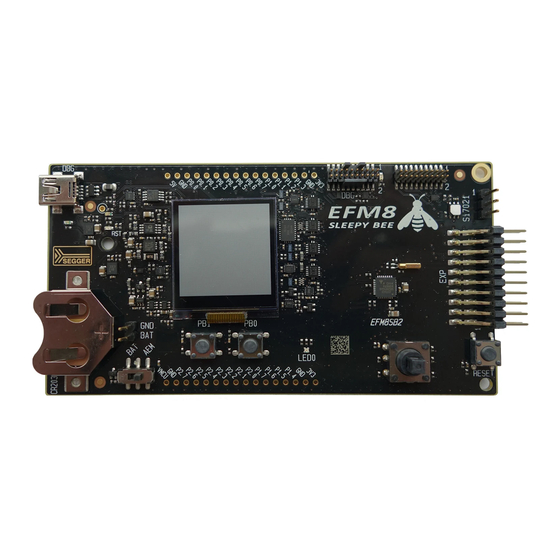
Silicon Laboratories EFM8SB2 Manuals
Manuals and User Guides for Silicon Laboratories EFM8SB2. We have 1 Silicon Laboratories EFM8SB2 manual available for free PDF download: Reference Manual
Silicon Laboratories EFM8SB2 Reference Manual (285 pages)
EFM8 Sleepy Bee Family
Brand: Silicon Laboratories
|
Category: Microcontrollers
|
Size: 1 MB
Table of Contents
-
-
Memory Map11
-
-
Introduction22
-
Features24
-
Scratchpad28
-
-
6 Interrupts
32-
Introduction32
-
-
-
Introduction45
-
Features46
-
Idle Mode46
-
Stop Mode46
-
Suspend Mode47
-
Sleep Mode48
-
-
-
Introduction52
-
Features52
-
-
-
Introduction62
-
Features62
-
Interface62
-
-
-
Introduction77
-
Features77
-
Device Reset78
-
RTC Reset81
-
-
-
Introduction93
-
Features93
-
INT0 and INT1100
-
Port Match100
-
-
-
Introduction127
-
Features128
-
Clocking128
-
Ground Reference129
-
Input Selection129
-
Gain Setting130
-
Input Tracking130
-
Burst Mode133
-
8-Bit Mode133
-
-
-
Introduction146
-
Features146
-
Overview146
-
-
-
Introduction148
-
Features148
-
Hysteresis149
-
Input Selection149
-
Output Routing152
-
-
-
Introduction159
-
Features159
-
Bit Reversal162
-
-
-
Introduction166
-
Features166
-
Counter / Timer167
-
16-Bit PWM Mode174
-
PCA0MD: PCA Mode178
-
-
-
Introduction194
-
Features194
-
Overview195
-
EMIF Pin Mapping195
-
Operating Modes198
-
Timing200
-
Multiplexed Mode201
-
-
-
Introduction208
-
Features208
-
Signals209
-
-
-
Introduction224
-
Features224
-
Smbus Protocol225
-
-
-
Introduction245
-
Features245
-
Capture Mode254
-
Advertisement
Advertisement
Related Products
- Silicon Laboratories EFM8SB1-SLSTK2010A
- Silicon Laboratories EFM8 Series
- Silicon Laboratories EFM8UB1-SLSTK2000A
- Silicon Laboratories EFM8BB2-SLSTK2021A
- Silicon Laboratories EFM8SB2-SLSTK2011A
- Silicon Laboratories EFM8BB3-SLSTK2022A
- Silicon Laboratories EFM32
- Silicon Laboratories EFM32 EFM32GG11 Giant Gecko Series
- Silicon Laboratories EFM32GG11-SLSTK3701A
- Silicon Laboratories EFM32GG-STK3700